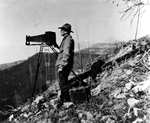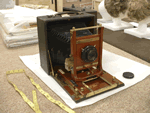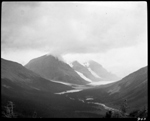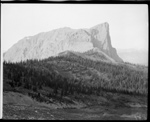
Photographing in the Rockies
Charles D. Walcott used photography to document his scientific work. In 1905 he began experimenting with panoramic photography. By the time of his last field expedition in 1925, he had created more than 600 panoramas of the Canadian Rockies. Initially his photography was utilitarian, but once true panoramic cameras became available, Walcott created striking images. He used Al-Vista and Cirkut cameras, bringing enough photographic equipment to load one pack horse. However, photography in the field was no simple matter. Even though Walcott preferred glass-plate negatives in an 8” x 10” format because they could be developed on site, it was difficult to bring heavy glass over the mountains. Walcott complained that flexible (plastic or cellulose nitrate) film often fogged before he could get it developed in Washington. The advantage of flexible film was in the sweeping panoramic views it could record. With no easy way to develop film in camp, it was hard to tell if the camera needed adjusting. Walcott set up a system with the Smithsonian’s official photographer, T. W. Smillie. At the start of each expedition, Walcott took a few test shots and shipped the negatives to Washington. Smillie made prints and sent a telegram to Walcott, advising him on technical problems and exposure. Walcott then made adjustments and proceeded to more remote locations. Getting these shots required patience and skill. Walcott commented: “Often in the Canadian Rockies days will pass in which atmospheric conditions are unfavorable to an extended view – dust blown in from the plains, smoke from forest fires…the best conditions usually occur after a heavy storm of either snow or rain has cleared the air.” (National Geographic Magazine, May 1913) In later years, Walcott’s photographs accompanied magazine articles, brochures for the Canadian Pacific and Grand Trunk Pacific Railways, lectures and especially his Smithsonian scientific publications. Walcott’s images offer both the scenic grandeur of the Rockies and the documentary evidence of a geologist at work. -Adapted from “The Panoramic Photography of Charles D. Walcott” by Michael Horsley, Panorama, Summer 2002, Vol.19, No.2 |
|
|
|
|
|
|
|
View of cliff of Mt. Burgess from west slope of Mt. Field, 1910 |




